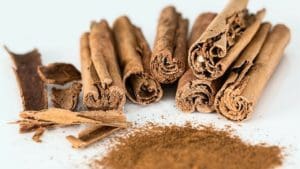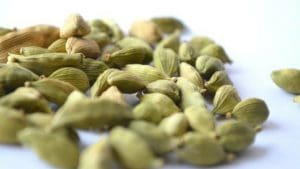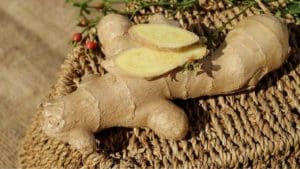It’s cough and cold season. Have you kept it at bay so far, or are you suffering? Are you cringing on the bus, or in the office, when somebody sneezes?
Winter is particularly challenging to our immune system and viruses love to use us weakened humans as hosts. The result is plenty of snot, pain, headache and missed opportunities to shine.
Before you hand over your cash at the late-night chemist, check out these family-safe, natural remedies from Ayurveda. They not only boost your natural immunity and ease pain, they taste good too.
Sitophaladi churna is a sweet herbal powder used to treat respiratory system diseases like cold, cough, chronic tonsillitis, chest congestion, asthma, allergy, also digestive complaints, hyperacidity, fever, burning sensations, nosebleeds. This powerful, yet gentle combination is warming, digestive (aids digestion of foods and toxins), pain relieving, expels mucous, relieves fever, opens the bronchioles for better oxygen intake and absorption, reduces mast cells proliferation (which cause the allergic response), relieves headache and clears sinus congestion.
Dose: About ¼- ½ teaspoon (1-3g) in hot water as tea or mixed with honey, three to four times daily after food.
- For a wet/productive cough – honey soothes and aids expectoration.
- For a dry cough – also add ghee to soothe and lubricate.
- Sitophaladi (with honey) is quite safe to lick off a spoon periodically while your throat is sore.
Infants: 1 pinch with honey three times a day after feeding.
Children : 4 pinches with honey three times a day after food.
Side effects: may cause some discomfort if taken on an empty tummy or loose stools in excess (don’t take more than 10g powder daily).
Contraindications: Diabetic patients should exercise caution due to high sugar content. They can drink ginger, cardamom, cinnamon and lemon tea instead, with minimal (think 1/4 teaspoon) honey.
Ingredients:
| Common name | Sanskrit name | Botanical Name | Action |
| Sun dried sugar cane juice /Rock candy | Sitophala | Saccharum officinarum | Carrier for herbal preparations, used to ‘tempt’ krimi (worms/parasites/bacteria/viruses) out of hiding so they can be blasted by herbs, demulcent, soothing, settling, rejuvenative. |
| Bamboo | Vamsha-lochana | Bambusa bambos | Relieves respiratory problems, soothing pain relief, digestive, kills krimi, rejuvenative. |
| Long Pepper | Pippali | Piper longum | Potentiser, and carrier, rejuvenative, vasodilator, relieves flatulence and bloating. Kills krimi and strengthens the liver. |
| Cardamom | Ela | Elettaria cardamom | Digestive herb known to aid gut microbiome, eases nausea and cramping. In India, used when introducing baby to new foods to aid assimilation. Cooling but lightening, soothes burning within the body, settles fever and acidity. Cleanses the passages of the head and lungs. Soothes sore throat. (see note on Fever) |
| Cinnamon | Twak | Cinnamum zeylanicum | Pungent, warming digestive with anti- bacterial and anti-fungal properties. Breaks up and expels mucous congestion. Increases appetite, cleanses blood, diaphoretic, stimulating and warms from within. |


Thaleesapatradi churna (-adi means ‘and others’) is the big sister to Sitophaladi churna. It is used in chronic and ‘deeper’ conditions such as whooping cough, sprue, anaemia and liver damage.
Thaleesapathradi churna contains three additional herbs to Sitophaladi:
| Common Name | Sanskrit | Botanical Name | Action |
| Himalayan Silver Fir | Thaleesapatra | Abies webbiana | Bronchodilator, antitussive, expectorant, anti-inflammatory, carminative used for respiratory disease, headache and mental stress |
| Black pepper | Maricha | Piper nigrum | This hot herb increases enzymatic action to ‘burn’ toxins and ‘bugs’. Decongestive, corrects misplaced heat in fever, normalises digestive fire and rejuvenates respiratory system. |
| Shunti | Ginger | Zingiber officionale | Pungent digestive which increases peripheral circulation, clears ama and phlegm, anti-inflammatory and analgesic. |
 These magic formulae won’t just help you deal with colds, they’ll improve your overall health and may reduce your ongoing allergic reactivity. Check out the indications from Dr JV Hebbar.
These magic formulae won’t just help you deal with colds, they’ll improve your overall health and may reduce your ongoing allergic reactivity. Check out the indications from Dr JV Hebbar.
In cold season its best to use common sense. Obviously, continue to avoid allergens and triggers. Keep warm and cover the throat and ears in cold winds. Practise excellent hand hygiene especially when runny noses are about. Add delicious spices like ginger/turmeric/garlic/cinnamon /pepper/paprika to your vata-pacifying winter diet and get enough rest. Following seasonal routines means you should be getting more sleep. This will boost immunity as well as cutting down on heating and power costs.
If you’re ill, REST. Don’t take your colony of bugs on the train to share with everyone else! Make a soup and take some Sitophaladi Churna. Try some steam inhalation with eucalyptus oil, drink plenty of warm water and herbal teas.
Mucus is like kapha – hard, sticky, cold and often white. So, utilise opposite qualities to clear it out and speed your recovery. Think hot and warm; smooth, not sticky. Avoid cold and hard like ice-cream, cold drinks, milk, cheese and bananas (unless you cook them with cinnamon), avoid junk and fried food.
A (restrained) note on Fever:
Fever is the body’s natural and super effective way of cooking off most pathogens which we’d regularly encounter. Those which most often invade our body are called mesophiles and they thrive at temperatures around 37oC. Also, in fever, we produce elevated levels of pathogen and cancer fighting interferons plus a cascade of cellular signals are activated to upregulate the fight against these invaders.
Yes, kids have bright shiny immune systems which react hard and fast, that’s why we watch them carefully, we NURSE them. On the flip side, reaching for the anti-inflammatory medication every time your body has a symptom may allow these bugs to replicate more, leading to prolonged illness or damaging your internal immune pathways so you’re more susceptible to future infection.
